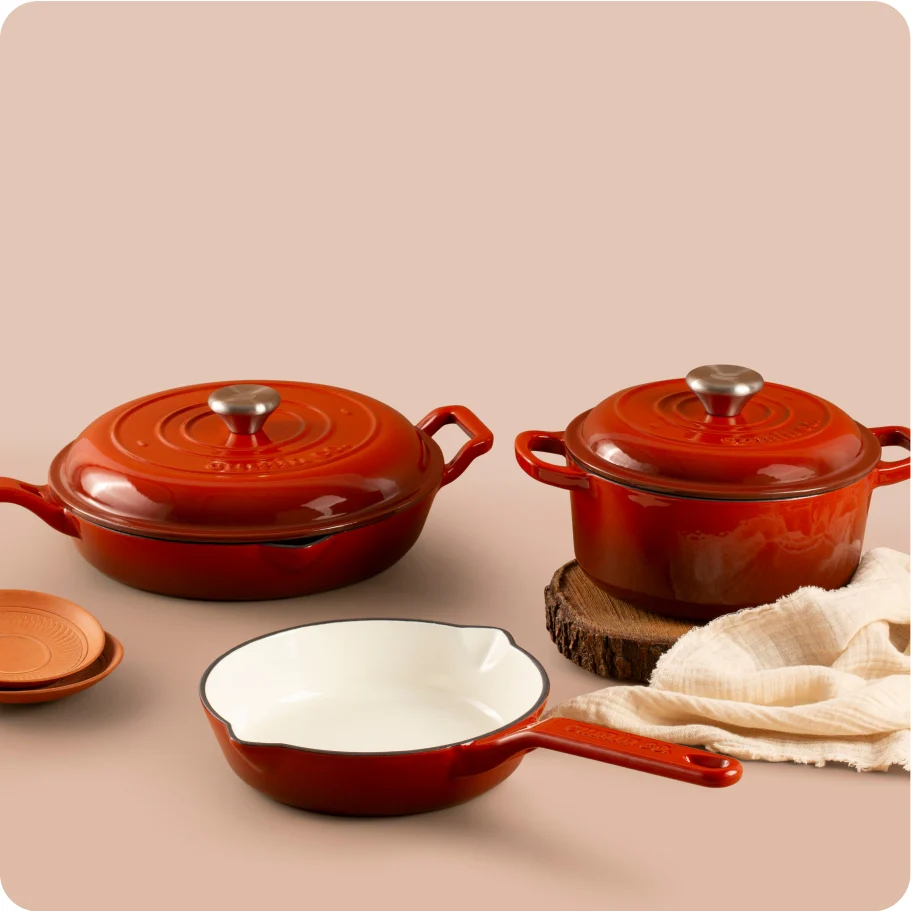Breaking Myths About Cast Iron Cookware – Facts Every Cook Should Know

Cast iron cookware has been around for centuries, yet many myths still surround its use. Some people believe cast iron is too high-maintenance, while others think it’s only good for frying. But what’s the truth?
This guide will debunk common myths about cast iron cookware and reveal why it’s one of the best investments for your kitchen.
Myth #1: Cast Iron is Difficult to Maintain
The Truth:
- Enamel-coated cast iron requires no seasoning and is easy to clean.
- Traditional cast iron only needs a thin layer of oil after washing to maintain seasoning.
- If maintained properly, cast iron gets better with use rather than wearing out.
How to Maintain Cast Iron:
- Wash with mild soap (enamel-coated) or warm water (pre-seasoned).
- Dry immediately to prevent rust.
- Apply a thin coat of oil for seasoning (pre-seasoned only).
Myth #2: Cast Iron Takes Too Long to Heat Up
The Truth:
- Cast iron does take longer to heat than aluminum, but it retains heat better.
- Once hot, it stays at a consistent temperature, ensuring even cooking.
- This makes it ideal for dishes that require steady heat, like rotis, dosas, and stews.
Cooking Tip: Preheat your cast iron pan for 3–5 minutes before cooking for the best results.
Myth #3: Cast Iron Reacts with Acidic Foods
The Truth:
- Enamel-coated cast iron is completely safe for acidic foods.
- Pre-seasoned cast iron can react with acidic foods if not properly seasoned.
- If your pan is well-seasoned, cooking tomato-based curries and lemon dishes is perfectly safe.
Best Practice: Use enamel-coated cast iron for tomato sauces, curries, and citrus-based dishes.
Myth #4: Cast Iron is Only for Frying
The Truth:
- Cast iron is incredibly versatile—it can fry, sauté, bake, roast, and even grill.
- It’s perfect for making crispy dosas, biryanis, and slow-cooked stews.
- Dutch ovens, tawas, and skillets make cast iron ideal for both everyday cooking and special dishes.
Myth #5: Cast Iron Rusts Easily and is Unsafe
The Truth:
- Rust only forms if cast iron is left wet.
- If rust appears, it can be easily removed with vinegar and baking soda.
- Regular use and proper drying keep cast iron in perfect condition.
Prevention Tip: Always dry cast iron immediately after washing and store in a dry place.
Myth #6: You Can’t Use Soap on Cast Iron
The Truth:
- Enamel-coated cast iron can be washed with soap and water.
- Mild soap won’t harm pre-seasoned cast iron if followed by re-oiling.
- Avoid harsh detergents that can strip seasoning.
Myth #7: Metal Utensils Ruin Cast Iron
The Truth:
- Enamel-coated cast iron should be used with wooden or silicone utensils.
- Pre-seasoned cast iron can handle metal utensils without damage.
- Scraping food off doesn’t ruin seasoning—just reseason if needed.
Myth #8: Cast Iron is Too Heavy to Use Daily
The Truth:
- Cast iron is heavier than stainless steel or aluminum, but it’s worth it for its durability and even heat distribution.
- Handles designed as part of the body provide better balance and control.
- Many cooks find cast iron more stable and easier to cook with once they adjust to the weight.
Final Thoughts: The Truth About Cast Iron Cookware
Cast iron is a versatile, durable, and safe cookware option that improves over time. With proper care, it’s easy to maintain and can be used for a wide range of dishes.
Don’t let myths keep you from experiencing the superior cooking benefits of cast iron. Try it out and see why generations of cooks swear by it!
 Pots and Pans
Pots and Pans
 Tawa
Tawa Kitchen Accessories
Kitchen Accessories












